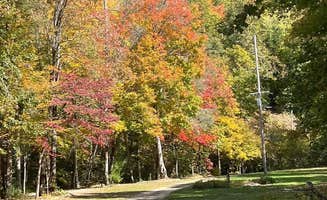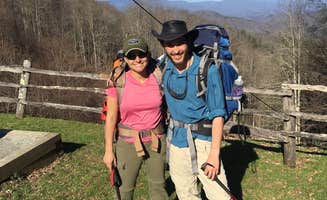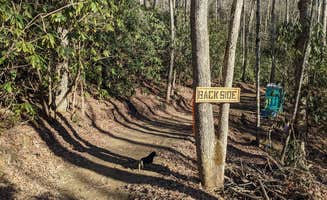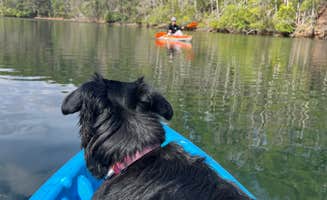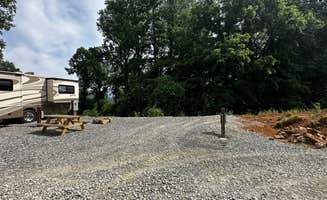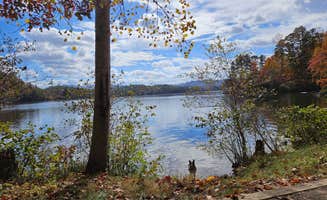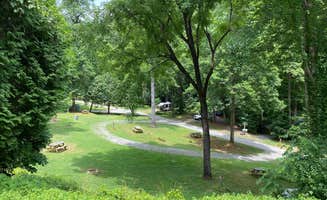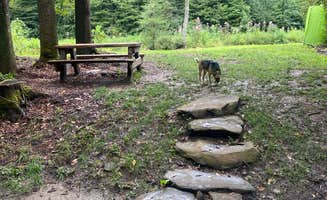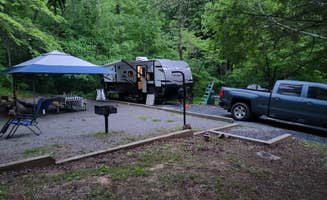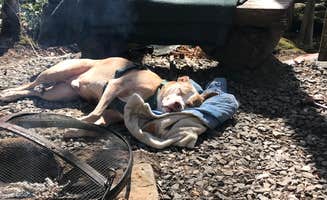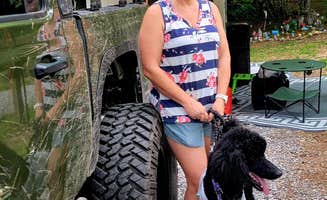Lake Santeetlah Dispersed camping offers primitive wilderness experiences in the mountains of western North Carolina. Positioned at elevations between 1,900 and 3,500 feet, this area experiences dramatic seasonal changes with vibrant fall colors and spring wildflower displays. The forest floor consists primarily of rich, acidic soil that drains quickly after rainfall but can become slick on steeper terrain.
What to do
Motorcycle touring on nearby routes: The famous Tail of the Dragon (Highway 129) between North Carolina and Tennessee offers 318 curves in 11 miles, making it popular with motorcyclists staying at Long Hungry Road Dispersed Campsites. "Very beautiful place but slim pickings on the open spots. We found site 2 empty the only site not on the lake. Seems like people setup tents to hold sites and don't return for days," notes camper Darrin C.
Creek wading and swimming: Most sites at Horse Cove offer direct water access. "Very quite sites tucked away beside the river, about 5 or 6. Then across the street is about 10 more sites. I love falling asleep to sound of rushing water. You can fill your days hiking the local trails or trekking down river," reports Joshua K. The shallow creeks provide natural cooling during summer months.
Biking specific trails: Tsali Recreation Area maintains dedicated cycling days. "This is the campground to stay if you want to mountain bike. The Tsali system starts right from the campground. You can ride to & from your campsite and never have to load up," explains Tony C. The trail system alternates usage days between mountain bikers and horseback riders to prevent conflicts.
What campers like
Private lake access points: Many campsites at Lake Santeetlah Dispersed include their own mini-peninsulas. "Our site was a quarter mile peninsula that we had to ourselves. All the sites very in size, shape, and proximity to the road and lake, and they all were nice. The lake itself is absolutely gorgeous and crystal clear," shares Andy S., who appreciated the wildlife watching opportunities.
Clean bathhouse facilities: Despite the remote location, Turkey Creek maintains exceptional cleanliness. "Cleanest bathrooms I have ever seen at a campground. This was my second time here and I will go back when I am in the area," says Jason L. The bathhouses include hot showers, making longer stays more comfortable even during cooler months.
Low light pollution for stargazing: The remote location minimizes artificial light, creating exceptional night sky viewing. "We arrived at the perfect hour of the day and had our pick of any site. We chose #12, for its privacy and the beautiful rushing water to sleep by and watch while sitting beside the fire," notes vickie V. about Horse Cove. Campers recommend bringing red-filter flashlights to maintain night vision.
What you should know
Limited cell service: Most forest campgrounds have minimal connectivity. At Turkey Creek Campground, one camper advises: "Make sure you download a google map 'offline mode' map of the area before coming, since service is limited for ATT and Verizon." This preparation ensures you can navigate without relying on cellular data.
Steep access roads: Many campgrounds require navigating challenging mountain roads. "The driveway coming into the campground is steep, so drive slow, and I would highly recommend showing up before dark, not an entrance I would want to make after dark," warns Adam C. This is particularly important during wet weather when gravel roads become slippery.
Bear safety requirements: All campsites require proper food storage. "This is bear country, so your food and toiletries need to be locked in a vehicle or hard-side camping unit; there are some food storage lockers provided for the walk-in sites," explains a camper at Elkmont Campground. Rangers actively enforce these rules to prevent wildlife conflicts.
Tips for camping with families
Test backpacking readiness: Horse Cove offers walk-in sites that serve as training for longer trips. "It was a great test to see if our girls were ready to try backpacking because of the hike. Sadly we learned they were not but they loved the site and the short hike to the grounds," shares Cheryl B., who found the short walk-in sites perfect for children not quite ready for true backcountry camping.
Community campgrounds for social kids: Cades Cove Campground creates opportunities for children to interact. "That doesn't make it good or bad, but you need to know what to plan for. If you want nature and solitude, go somewhere else. If you want nature, love community, and want someone for your kids to play with, this is perfect," advises DrDavid P.
Creekside sites for natural play: Children enjoy the natural water features at many dog-friendly campgrounds near Bear Creek. "The headwaters of the Nantaha River flow through the campground providing a gathering place for families to enjoy playing in a cold mountain stream," describes Nancy R. at Standing Indian Campground. These shallow streams create natural playgrounds without electronics.
Tips from RVers
Size restrictions matter: Many forest campgrounds have limited space for larger vehicles. "Unless there is another way into this lovely park that I am unaware of, I would not attempt to tow a 5th wheel or other large trailer to this location. Tow your pop-up or pitch a tent. You'll be glad you came," cautions John K. about Standing Indian Campground.
Limited hookup availability: Most pet-friendly national forest campsites offer minimal amenities. "They have RV sites that have electric and water only, but have a dump station on the way out," explains Brad Y. about Turkey Creek Campground. This means proper tank management becomes essential for longer stays.
Advance planning required: RV-friendly sites fill quickly during peak seasons. "Be sure to reserve far in advance, as this is a very popular campground! Great sites, and a short drive to Tsali Rec area," advises bart at Turkey Creek Campground, noting the increased competition for larger sites with amenities.


